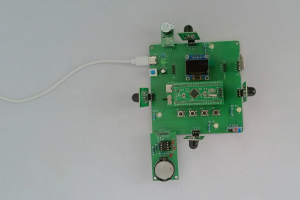设计说明书
总字数:19000+
摘要
随着智能建筑与节能理念的发展,公共区域的灯光精准控制对降低能耗、提升使用体验具有重要意义。传统的灯光控制方式多依赖人工开关,存在忘关浪费、光照不适配等问题,难以满足现代化场所对智能化、节能化管理的需求。
基于 STM32F103C8T6 单片机的灯光控制系统,整合了 D203S 人体红外传感器、5516 光照检测模块、DS1302 时钟模块、4 个独立按键、OLED 显示屏、WiFi 模块及 LED 灯组,实现了多区域灯光的自动化与智能化控制。系统核心功能包括:通过 D203S 检测四个区域的人体活动,结合 5516 模块的光照数据,当检测到有人且光照低于阈值时,自动以最亮状态开启对应区域 LED 灯,人离开后自动关闭;借助 DS1302 获取时间,支持按键修正时间并设定熄灯时段,时间到达后触发 5 次声光报警,10 分钟后自动关闭所有灯光;通过独立按键可设置光照阈值、调节各灯亮度;OLED 显示屏实时显示各区域状态、时间及参数;WiFi 模块实现数据上传至手机端,支持远程设置阈值与控制亮度。
该系统的实现,有效解决了传统灯光控制的能耗高、管理繁琐等问题,提升了灯光控制的智能化与节能性,为校园、办公楼等公共区域的照明管理提供了高效解决方案,同时为同类智能控制系统的研发提供了参考,具有较高的实用价值。
关键词:STM32F103C8T6;灯光控制;人体感应;智能节能;WiFi 远程控制
ABSTRACT
With the development of smart buildings and energy-saving concepts, precise lighting control in public areas is of great significance for reducing energy consumption and improving user experience. Traditional lighting control methods mostly rely on manual switching, which have problems such as waste from forgotten shutdowns and mismatched lighting, making it difficult to meet the needs of modern places for intelligent and energy-saving management.
The lighting control system based on the STM32F103C8T6 microcontroller integrates D203S human infrared sensors, 5516 light detection modules, DS1302 clock modules, 4 independent buttons, OLED displays, WiFi modules, and LED lamp groups, realizing automatic and intelligent control of multi-area lighting. The core functions of the system include: detecting human activity in four areas through D203S, combined with light data from 5516 modules—when a person is detected and light is below the threshold, the corresponding LED light is automatically turned on at maximum brightness and turns off after the person leaves; obtaining time via DS1302, supporting time correction through buttons and setting a lights-out time, which triggers 5 sound and light alarms when reached, and automatically turns off all lights after 10 minutes; setting thresholds and adjusting each light’s brightness through independent buttons; real-time display of area status, time and parameters on the OLED screen; data upload to mobile phones via WiFi module, supporting remote threshold setting and brightness control.
The implementation of this system effectively solves the problems of high energy consumption and cumbersome management in traditional lighting control, improves the intelligence and energy efficiency of lighting control, provides an efficient solution for lighting management in public areas such as campuses and office buildings, and offers a reference for the research and development of similar intelligent control systems, with high practical value.
Keywords:STM32F103C8T6; Lighting control; Human body induction; Intelligent energy saving; WiFi remote control
目录
第 1 章 绪论
1.1 研究的目的及意义
1.2 国内外发展情况
1.3 本文主要研究内容
第2章 设计思路与方案论证
2.1 主要元器件选择
2.1.1 主控芯片选择
2.1.2 人体红外传感器选择
2.1.3 光照检测模块选择
2.1.4 时钟模块选择
2.1.5 按键模块选择
2.1.6 显示模块选择
2.1.7 WiFi 模块选择
2.1.8 声光报警模块选择
2.2整体设计方案
第 3 章 硬件设计
3.1 主控电路模块
3.2 人体红外传感器电路
3.3 光照检测模块电路
3.4 时钟模块电路
3.5 LED 灯驱动电路
3.6 按键模块电路
3.7 显示模块电路
3.8 WiFi 模块电路
3.9 声光报警模块电路
第4章 系统程序设计
4.1 编程软件介绍
4.2 系统主流程设计
4.3 独立按键
4.4 OLED显示流程设计
4.5 时钟模块子流程设计
4.6 WiFi模块子流程设计
第 5 章 实物测试
5.1 整体实物测试
5.2 人体红外传感器功能测试
5.3 光照检测模块功能测试
5.4 时钟模块功能测试
5.5 LED 灯控制功能测试
5.6 按键设置功能测试
5.7 显示功能测试
5.8 WiFi 模块功能测试
5.9 声光报警模块功能测试
第 6 章 总结与展望
6.1 总结
6.2 展望
致谢
参考文献
附录
附录一:原理图
附录二:PCB
附录三:主程序
购买后可查看具体内容!

